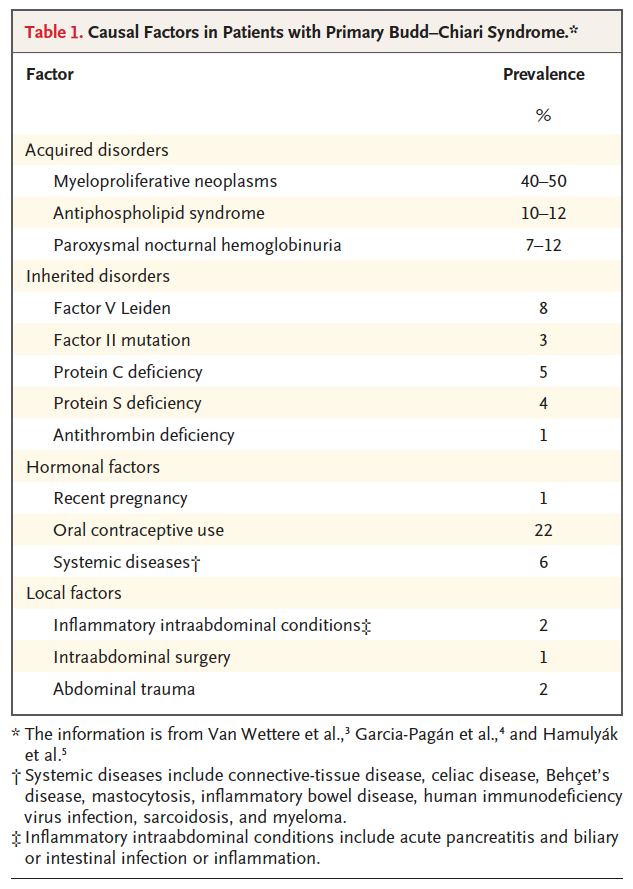Primary Budd–Chiari Syndrome
This blog post discusses Primary Budd–Chiari Syndrome, a spontaneously fatal disease characterized by an obstruction of the hepatic venous outflow tract due to thrombosis or a primary disease of the venous wall. It also mentions the prevalence estimate of the disease and the median age at diagnosis.

NEJM
The New England Journal of Medicine (https://t.co/YGfDrRsIhE) is the world’s leading medical journal and website.

-
Primary Budd–Chiari syndrome (BCS) is a spontaneously fatal disease characterized by an obstruction of the hepatic venous outflow tract due to thrombosis or a primary disease of the venous wall. Full article: https://t.co/bY9cCrUx8O 1/15
— NEJM (@NEJM) April 7, 2023 -
The primary form of BCS is extremely rare, with the prevalence estimate (1 case per 1 million persons per year) falling well below the threshold of 2 cases per 10,000 for rare diseases. The median age at diagnosis is 35 to 40 years. 2/15
— NEJM (@NEJM) April 7, 2023 -
The two sexes appear to be equally affected. Recent advances have changed our understanding of this disease, as well as the outcomes. 3/15
— NEJM (@NEJM) April 7, 2023 -
An underlying disorder, such as a hereditary or an acquired hypercoagulable state, can be found in approximately 75% of patients, and in at least 1/3 of patients, >1 prothrombotic condition is identified. BCS may develop during pregnancy or in the postpartum period. 4/15 pic.twitter.com/dk5RFDccQr
— NEJM (@NEJM) April 7, 2023 -
Demographic and clinical characteristics of patients with BCS are extremely varied and nonspecific. The absence of clinical manifestations is not rare. The combination of abdominal pain, fever, an enlarged liver, and ascites of recent onset is far from common. 5/15 pic.twitter.com/AOebcOjQm6
— NEJM (@NEJM) April 7, 2023 -
Therefore, it is important to evaluate for an obstructed hepatic venous outflow tract in any patient with any form of acute or persistent liver anomalies. 6/15
— NEJM (@NEJM) April 7, 2023 -
The presence of large, subcutaneous cavocaval collaterals on the trunk, seen on physical examination, is a specific manifestation of an obstruction of the inferior vena cava that allows for a rapid diagnosis. 7/15
— NEJM (@NEJM) April 7, 2023 -
Venovenous collaterals, mostly intrahepatic but also extrahepatic, are usually present at varying degrees of development. In patients with obstruction of the terminal portion of the IVC, cavocaval collaterals can develop, although the bypass routes are not predictable. 8/15 pic.twitter.com/ECsBkBwBRJ
— NEJM (@NEJM) April 7, 2023 -
At the time of diagnosis, hepatic and portal venous obstructions are seen together in ~20% of patients. Portal venous obstruction is usually caused by a thrombus and less frequently caused by a cavernoma. It is common to find parenchymal nodules of various sizes and numbers. 9/15
— NEJM (@NEJM) April 7, 2023 -
Assessment of liver stiffness, often measured with the use of ultrasonography or MRI, shows markedly increased values. Increased liver stiffness appears to be related largely to congestion of the liver, in addition to fibrosis. 10/15
— NEJM (@NEJM) April 7, 2023 -
Typical histopathological changes predominate in centrilobular areas. Fibrosis may eventually evolve to cirrhosis, with altered hepatic venules at the periphery and a portal tract at the center of the nodules. 11/15 pic.twitter.com/0ziHnmfLbj
— NEJM (@NEJM) April 7, 2023 -
BCS is associated with high mortality (>80% at 3 years). However, the risk markedly changes if the diagnosis is established early and adequate management is provided. Indeed, when BCS is managed appropriately, survival at 5 years exceeds 80%. 12/15
— NEJM (@NEJM) April 7, 2023 -
Several prognostic scores have been developed, all of which are useful in classifying the severity of BCS. 13/15 pic.twitter.com/o0uhJJ4egX
— NEJM (@NEJM) April 7, 2023 -
In addition, an alanine aminotransferase level that is 5 or more times the upper limit of the normal range at presentation and that does not decrease rapidly in the next few days has been associated with a poor outcome. 14/15
— NEJM (@NEJM) April 7, 2023 -
Read the full Review Article “Primary Budd–Chiari Syndrome” by Juan Carlos Garcia‑Pagán, M.D., Ph.D., and Dominique‑Charles Valla, M.D.: https://t.co/bY9cCrUx8O 15/15#Gastroenterology #LiverDisease
— NEJM (@NEJM) April 7, 2023
